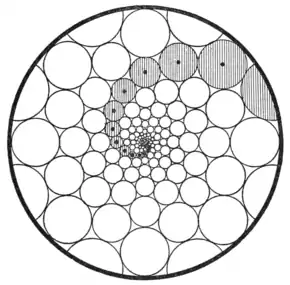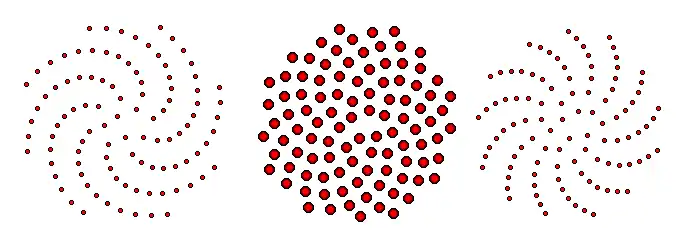Doyle spiral
In the mathematics of circle packing, a Doyle spiral is a pattern of non-crossing circles in the plane, each tangent to six others. The sequences of circles linked to each other through opposite points of tangency lie on logarithmic spirals (or, in degenerate cases, circles or lines) having, in general, three different shapes of spirals.


These patterns are named after mathematician Peter G. Doyle, who made an important contribution to their mathematical construction in the late 1980s or early 1990s.[2] However, their study in phyllotaxis (the mathematics of plant growth) dates back to the early 20th century.[3][1]
Parameterization
The precise shape of any Doyle spiral can be parameterized by a pair of natural numbers describing the number of spiral arms for each of the three ways of grouping circles by their opposite points of tangency. If the numbers of arms of two of the three types of spiral arm are and , with and with fewer than arms of the third type, then the number of arms of the third type is necessarily . As special cases of this formula, when the arms of the third type degenerate to circles, and there are infinitely many of them. And when the two types of arms with the smaller number of copies are mirror reflections of each other and the arms with copies degenerate to straight lines. For example, in the illustration shown, there are eight spiral arms with the same shape as the shaded arm, another eight spiral arms with the mirror reflected shape, and sixteen radial lines of circles, so this spiral can be parameterized as , .[4]
Alternatively, the Doyle spiral can be parameterized by a pair of real numbers and describing the relative sizes of the circles. Peter Doyle observed that, when a unit circle is surrounded by of six other circles with radii , , , , , and , then these six surrounding circles close up to form a ring of mutually tangent circles, all tangent to the central unit circle.[2] The Doyle spiral can then be constructed by using the same relative radii for rings of six circles surrounding each previously-constructed circle. The resulting system of circles closes up on itself to form a non-crossing Doyle spiral of circles in the plane only for certain special pairs of numbers and , which can be found from the integer parameters and by a numerical search. When is not one of these special pairs, the resulting system of circles still consists of spiral arms all wrapping around a central point, but with a rotation angle around that central point that is not an integer fraction of , causing them to overlap non-locally. The two real parameters can also be combined into a single complex number, interpreting the plane in which the circles are drawn as the complex plane.[4] The parameters associated with a Doyle spiral must be algebraic numbers.[5]
Special cases
.svg.png.webp)
.jpg.webp)
Coxeter's loxodromic sequence of tangent circles is a Doyle spiral with parameters and or with and , where denotes the golden ratio. Within the single spiral arm of tightest curvature, the circles form a sequence whose radii are powers of , in which each four consecutive circles in the sequence are tangent.[7]
The standard hexagonal packing of the plane by unit circles can also be interpreted as a degenerate special case of the Doyle spiral, the case obtained by using the parameters . Unlike other Doyle spirals, it has no central limit point.[4]
Applications
The Doyle spirals form a discrete analogue of the exponential function[4] Spirals of tangent circles have been used to study Kleinian groups.[8]
Spirals of tangent circles, often with Fibonacci numbers of arms, have been used to model phyllotaxis, the spiral growth patterns characteristic of certain plant species, beginning with the work of Gerrit van Iterson in 1907.[3] In this application, a single spiral of circles may be called a parastichy and the parameters and of the Doyle spiral may be called parastichy numbers. The difference is also a parastichy number (if nonzero), the number of parastichies of the third type. When the two parastichy numbers and are either consecutive Fibonacci numbers, or Fibonacci numbers that are one step apart from each other in the sequence of Fibonacci numbers, then the third parastichy number will also be a Fibonacci number.[9] For modeling plant growth in this way, spiral packings of tangent circles on surfaces other than the plane, including cylinders and cones, may also be used.[10]
Spiral packings of circles have also been studied as a decorative motif in architectural design.[6]
Uniqueness and related patterns

The Doyle spirals (and the hexagonal packing of the plane) are the only possible "coherent hexagonal circle packings" in the plane, where "coherent" means that no two circles overlap and "hexagonal" means that each circle is tangent to six others that surround it by a ring of tangent circles.[4] Applying a Möbius transformation to a Doyle spiral can produce a related pattern of non-crossing tangent circles, each tangent to six others, with a double-spiral pattern in which the connected sequences of circles spiral out of one center point and into another; however, some circles in this pattern will not be surrounded by their six neighboring circles.[7][8]
Additional patterns are possible with six circles surrounding each interior circle but only covering a partial subset of the plane and with circles on the boundary of that region not completely surrounded by other circles.[11] It is also possible to form spiral patterns of tangent circles whose local structure resembles a square grid rather than a hexagonal grid, or to continuously transform these patterns into Doyle packings or vice versa.[9] However, the space of realizations of locally-square spiral packings is infinite-dimensional, unlike the Doyle spirals which can be determined only by a constant number of parameters.[12]
It is also possible to describe spiraling systems of overlapping circles that cover the plane, rather than non-crossing circles that pack the plane, with each point of the plane covered by at most two circles except for points where three circles meet at angles, and with each circle surrounded by six others. These have many properties in common with the Doyle spirals.[13]
The Doyle spiral, in which the circle centers lie on logarithmic spirals and their radii increase geometrically in proportion to their distance from the central limit point, should be distinguished from a different spiral pattern of disjoint but non-tangent unit circles, also resembling certain forms of plant growth such as the seed heads of sunflowers. This different pattern can be obtained by placing the centers of unit circles on an appropriately scaled Fermat's spiral, at angular offsets of from each other relative to the center of the spiral, where again is the golden ratio.[14][15] For more, see Fermat's spiral § The golden ratio and the golden angle.
References
- Emch, Arnold (November 1911), "Mathematics and engineering in nature", Popular Science Monthly, 79: 450–458
- Doyle's description of the six radii of the ring of disks surrounding a central disk in these spirals appears not to have been published; it is cited as an "oral communication" by Carter, Ithiel; Rodin, Burt (1992), "An inverse problem for circle packing and conformal mapping", Transactions of the American Mathematical Society, 334 (2): 861–875, doi:10.2307/2154486, MR 1081937, and described without citation as an observation of Doyle in Beardon, Dubejko & Stephenson (1994)
- Jean, Roger V. (May 1983), "Introductory review: Mathematical modeling in phyllotaxis: the state of the art", Mathematical Biosciences, 64 (1): 1–27, doi:10.1016/0025-5564(83)90025-1
- Beardon, Alan F.; Dubejko, Tomasz; Stephenson, Kenneth (1994), "Spiral hexagonal circle packings in the plane", Geometriae Dedicata, 49 (1): 39–70, doi:10.1007/BF01263534, MR 1261573
- Stephenson, Kenneth (2005), Introduction to Circle Packing: The Theory of Discrete Analytic Functions, Cambridge University Press, Cambridge, p. 326, ISBN 978-0-521-82356-2, MR 2131318
- Fernández-Cabo, M. C. (June 2017), "Tangent circles on the plane using variable compass", Journal of Architectural Engineering, 23 (2): 04017001, doi:10.1061/(asce)ae.1943-5568.0000233
- Coxeter, H. S. M. (1968), "Loxodromic sequences of tangent spheres", Aequationes Mathematicae, 1: 104–121, doi:10.1007/BF01817563, MR 0235456
- Wright, David J. (2006), "Searching for the cusp", in Minsky, Yair; Sakuma, Makoto; Series, Caroline (eds.), Spaces of Kleinian Groups, London Mathematical Society Lecture Note Series, 329, Cambridge University Press, pp. 301–336, MR 2258756
- Rothen, F.; Koch, A.-J. (1989), "Phyllotaxis or the properties of spiral lattices, II: Packing of circles along logarithmic spirals", Journal de Physique, 50 (13): 1603–1621, doi:10.1051/jphys:0198900500130160300
- Erickson, R. O. (1983), "The geometry of phyllotaxis", in Dale, J. E.; Milthorpe, F. L. (eds.), The Growth and Functioning of Leaves: Proceedings of a Symposium Held Prior to the Thirteenth International Botanical Congress at the University of Sydney 18–20 August 1981, Cambridge University Press, pp. 53–88
- Bobenko, Alexander I.; Hoffmann, Tim (2001), "Conformally symmetric circle packings: a generalization of Doyle's spirals", Experimental Mathematics, 10 (1): 141–150, MR 1822860
- Schramm, Oded (1997), "Circle patterns with the combinatorics of the square grid", Duke Mathematical Journal, 86 (2): 347–389, doi:10.1215/S0012-7094-97-08611-7, MR 1430437
- Bobenko, Alexander I.; Hoffmann, Tim (2003), "Hexagonal circle patterns and integrable systems: patterns with constant angles", Duke Mathematical Journal, 116 (3): 525–566, arXiv:math/0109018, doi:10.1215/S0012-7094-03-11635-X, MR 1958097
- Pickover, Clifford A. (July 1992), "On the aesthetics of inversion and osculation", The Visual Computer, 8 (4): 233–240, doi:10.1007/bf01900658
- Vogel, Helmut (June 1979), "A better way to construct the sunflower head", Mathematical Biosciences, 44 (3–4): 179–189, doi:10.1016/0025-5564(79)90080-4
Further reading
- Sutcliffe, Alan (2008), "Doyle spiral circle packings animated", in Sarhangi, Reza; Séquin, Carlo H. (eds.), Bridges Leeuwarden: Mathematics, Music, Art, Architecture, Culture, London: Tarquin Publications, pp. 131–138, ISBN 9780966520194
- Yamagishi, Yoshikazu; Sushida, Takamichi (April 2017), "Spiral disk packings", Physica D: Nonlinear Phenomena, 345: 1–10, doi:10.1016/j.physd.2016.12.003
